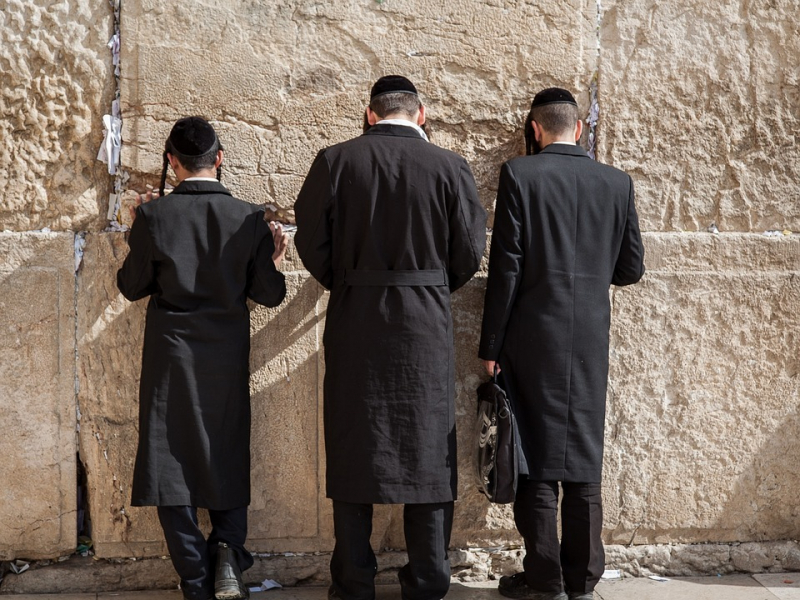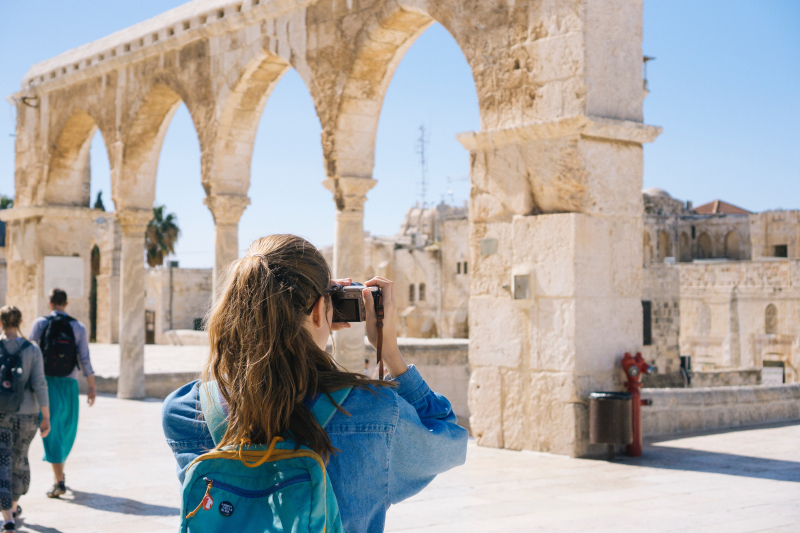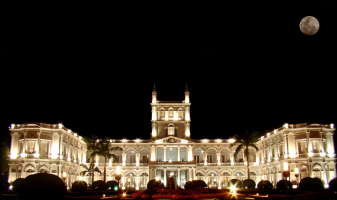Top 10 Best Places to Visit in Jerusalem
Tourists arriving in Israel most frequently travel to the historic city of Jerusalem. Walking through Jerusalem's winding stone passageways is like travelling ... read more...back in time; the city is home to some of Judaism's holiest sites in addition to historic churches and mosques. However, you do not have to be religious to visit. Beautiful archaeological monuments, top-notch gastronomy and culture, as well as the natural splendour of thriving oases and fauna, may all be found in Jerusalem. Here is the list of the best places to visit in Jerusalem.
-
The Israel Museum, Jerusalem was established in 1965 as the National Museum of Israel. The museum is located on a hill in Givat Ram, neighbouring Jerusalem, near the museum Museum Bible Lands, Campus for the Archeology of Israel, National Archaeological Site of Israel, Knesset, Supreme Court of Israel and " Hebrew University City of Jerusalem. The museum contains 500,000 archives, 7,000 of which can be viewed online.
The Israel Museum covers an area of nearly 50,000 square meters, attracting 800,000 visitors each year, including 100,000 children to Youth Wing. The Samuel Bronfman Bible District and the Archaeological Museum are part of the museum complex, hosting various archaeological finds. The Israel Museum has the largest collection of Israeli artefacts in the world. The archaeological wing contains fascinating exhibits from sites throughout the country ranging from the neolithic era through to the Ottoman era.
There are also adjacent galleries displaying art and artefacts from neighbouring cultures that influenced the culture and history of this land. The galleries cover ancient Egypt, Mesopotamia, ancient Greece, ancient Rome, and the Arabian Peninsula. The Israel Museum's art wing has a good collection of works by Israeli painters as well as pieces by Gauguin, Renoir, Van Gogh, and a range of works by international artists. There's also a regular program of contemporary art exhibitions.
Location: Jerusalem, Israel.
Website: https://www.imj.org.il/en
Tel: 972 2-670-8811
Hour: 10:00 AM - 17:00 PM
Google Rating: 4.7/5
Image by Kasher via unsplash.com 
Image by Anish Kapoor via pixabay.com -
For Christian pilgrims,Church of the Holy Sepulchrer is Jerusalem's holiest site and is said to have been built on the site where Jesus was crucified. The original church (built in 335 CE) was destroyed by 1009, and the grand church you see now dates from the 11th century. Although often heaving with pilgrims from across the world, the church interior is an opulently beautiful piece of religious architecture.
Inside the Church of the Holy Sepulchrer’s entrance is the Stone of Anointing, believed to be where Jesus’s body was prepared for burial. The modern mosaic along the wall depicts the anointing of Jesus’s body. Lamps with candles and incense hang along an ornate stand over the stone. The Roman Catholic, Eastern Orthodox, and Armenian Apostolic all have rightful access to the interior of the tomb, and all three hold Holy Mass there daily.
Each time, the Church of the Holy Sepulcher was rebuilt, some of the antiquities from the preceding structure were used in the newer renovation. As a tourist, you can visit the place and be a part of the hymn singing and chanting that takes part later during the noon. In addition, you can climb the steps to the Cavalry. There are various chapels too that one can visit here. Also, as Church of the Holy Sepulchrer is a religious site, it is advised to dress appropriately.
Location: Jerusalem, Israel.
Website: https://www.touristisrael.com/church-of-the-holy-sepulchre/28951/
Hour: 7:00 AM - 18:00 PM
Google Rating: 4.7/5

Image by Byzantium via unsplash.com 
Image by Julia Volk via pexels.com -
The Western Wall is the surviving retaining wall of Jerusalem's First Temple. Sometimes also called the Wailing Wall due to the people's laments for the loss of the temple in 70 CE, it is now the holiest site in Judaism and has been a place of pilgrimage for the Jewish people since the Ottoman era. King Herod built this wall in 20 BCE during an expansion of the Second Temple. When the Romans destroyed the temple in 70 CE, the support wall survived.
The wall splits into two sections, one area for males and the other for females. Traditionally, people visit from all over the world, to recite these prayers, and one can also write them down and put the paper in the cracks of the wall. The Western Wall is free to visit and is open 24 hours a day, year-round. Women and men should dress modestly in the Western Wall Plaza. To pray at the wall, women should have their legs and shoulders covered. Men should cover their heads. One of the best experiences a Jewish family can undertake is to have their child’s Bar or Bat Mitzvah at the Western Wall.Location: Jerusalem, Israel.
Website: https://thekotel.org/en/
Tel: 972 2-627-1333
Hour: Open all hours
Google Rating: 4.7/5
Image by Pixabay via pexels.com 
Image by Maor Attias via pexels.com -
The Citadel, popularly known as the Tower of David, actually has no connection with David, having been erected by King Herod to protect the palace he built in approximately 24 BCE. After Titus' conquest of the city in 70 CE, the Romans stationed a garrison here, but later the citadel fell into disrepair. The Tower Of David was successively rebuilt by the Crusaders, Egypt's Mamelukes, and the Ottomans, during their years of reign over Jerusalem.
At the Tower of David Museum, you are presented with Jerusalem’s astounding story. One can find maps, and audiotapes too! Each ancient room has been revamped to showcase a different period, allowing the tempestuous events of 4,000 years to fall perfectly into place in your mind. If you climb up to the citadel's rooftop, you are rewarded with one of the best Old City vistas in town. During the evening, the Tower of David is a Sound and Light show here, with visuals projected onto the city walls, which is particularly good for travelling families who want to introduce their children to some of the city's history.
Location: Jerusalem, Israel.
Website: https://israel.travel/tower-of-david-museum/
Tel: 972 2-626-5333
Hour: 8:00 AM - 16:00 PM
Google Rating: 4.6/5

Image by Roman Odintsov via pexels.com 
Image by Pixabay via pexels.com -
At the highest point in Jerusalem, just outside the walls of the Old City, lies modern Mount Zion. This mountain is home to Jewish and Muslim shrines as well as a number of churches. For Jews, Mount Zion's importance stems from this being the place of King David's Tomb. It was the site of the Jebusite city captured by David, king of Israel and Judah, in the 10th century BC and established by him as his royal capital.
Every year hundreds of thousands of tourists flock to Mount Zion to see representations of Biblical sites like the tomb of David and the Last Supper Room. If you climb up the stairs from the tomb's courtyard, you'll come to the Last Supper Room, which has served as both church and mosque throughout its long history. In Mount Zion, the Church of Dormition nearby is where the Virgin is supposed to have died, while just to the east is the Church of St. Peter of Gallicantu where Peter is said to have denied Jesus.Location: Jerusalem, Israel.
Website: https://www.seetheholyland.net/mount-zion/
Hour: Open all hours
Google Rating: 4.6/5

Image by Mick Haupt via pexels.com 
Image by James Lee via pexels.com -
The Armenian Quarter occupies the southwest corner of the Old City of Jerusalem. It covers one-sixth of the area contained inside the ancient walls. It is believed that between 35 and 25 B.C., the Jewish King, Herod built a fortress and his palace along the western wall of the Quarter which at that time was called The Upper City since it was relatively on higher ground than the other Quarters.
At the beginning of the twentieth century, this westernmost section of the Quarter was used as a cow pasture and to this day it is called such. The Armenian Quarter is reached through the Armenian Orthodox Patriarchate Road, a narrow, one-way street extending through the centre of the Quarter and ending at Zion Gate in the south. This street runs between the southern wall of the city and the Armenian cemetery adjacent to St. Savior Armenian Convent and the Biblical House of Caiaphas.
Over the last three centuries, The Armenian Quarter has been the burial place of many distinguished Patriarchs of Jerusalem as well as the resting place of members of the community and many pilgrims who met their reward while visiting the Holy Places. The centrepiece of the cemetery is a monument erected in memory of the fallen heroes of the Armenian Legion in 1917.
Location: Jerusalem, Israel.
Website: https://cnewa.org/magazine/jerusalems-armenian-quarter-30548/
Hour: Open all hours
Google Rating: 4.6/5
Image by Haley Black via pexels.com 
Image by Haley Black via pexels.com -
The Temple Mount is one of the most important sites to visit on any trip to Jerusalem. First established in 705 CE, it's among the oldest mosques in the world. The Temple Mount is the trapezoid-shaped, walled-in area in the southeastern corner of the Old City of Jerusalem. The four walls surrounding it date back – at least in their lower parts – to the time of the Second Jewish Temple, built at the end of the first century BCE.
The gaps between the walls and the Mount were filled to create a large surface area around the temple. There are also other substructures, the largest of which is known as Solomon’s stables. Visitors enter the Temple Mount complex through the Mughrabi Gate near the Western Wall. Many people will see the entrance as they walk through the Western Wall plaza on a tour of the Old City.
While admission is free, the site is only open during very specific times. The Temple Mount is closed to visitors on Friday and Saturday. The entrance to the site may be closed without notice for security reasons. Please check the status before planning your visit. In order to enter, both men and women need to be dressed modestly. No weapons are allowed and visitors may not bring in any sacred Jewish objects, such as a prayer book or a tallit.Location: Jerusalem, Israel.
Website: https://www.touristisrael.com/temple-mount/15944/
Hour: 7:00 AM - 15:00 PM
Google Rating: 4.6/5

Image by Mauricio Artieda via pexels.com 
Image by Pixabay via pexels.com -
Jerusalem Biblical Zoo got its start in 1940 as a small animal centre. As it grew and moved several times over the years, it also changed names. Located in the Malha valley, just 7 kilometres from the city centre, the 62-acre space is home to over 2,000 animals. The Jerusalem Biblical Zoo promotes social involvement, conducts research, and participates in national and international projects of conservation, breeding, and returning animals to the wild.
The Biblical Zoo has become Israel’s most visited attraction, thanks to its unique Jerusalem atmosphere and its zoological collection like no other in Israel. The zoo is divided into different exhibit areas where animals live in natural habitats, including an African Savanna area, a raptor aviary, an “underground world” focusing on animals that live below ground, and the “Bible Land Wildlife Preserve,” dedicated to animals that inhabited the area during Biblical times.Today, it operates under the name The Tisch Family Biblical Zoo in Jerusalem and also houses endangered species from around the world and especially from Afro-Asian areas. At the zoo, you will find an enchanting area for children, including a petting zoo and a living classroom, where you can encounter and get acquainted with a variety of animals up close, as well as an ecological playground.
Location: Jerusalem, Israel.
Website: https://www.jerusalemzoo.org/en/biblical-zoo
Tel: 972 2-675-0111
Hour: 09:00-18:00
Google Rating: 4.6/5
Image by Quang Nguyen Vinh via pexels.com 
Image by Denys Gromov via pexels.com -
Hurva Synagogue is one of the most impressive synagogues in the ancient Jewish Quarter in the Old City of Jerusalem and was built in the 16th century, but it was destroyed by the Ottomans. The synagogue became known as the Hurva, which means The Ruin because its reconstruction in the early 19th century was begun and then abandoned. In 1967, Louis Kahn received a commission to design Hurva Synagogue to replace the old destroyed Temple of Solomon.
This was a big opportunity for Kahn to express his ideas on architecture and to incorporate the elements of ruin in his building. The outer building of Hurva Synagogue consists of sixteen massive pylons, four on each side, recalling some ancient ruins. The plan was a perfect biaxial symmetry, however unpredictably, the entrances were on the narrow corners instead of on the axis.
In Hurva Synagogue, the first floor is designed to be a place for a bema, ark and candle service and the second floor is designed for seating. The most outstanding element in the final proposal is the series of four cylindrical openings on the axis piercing the ceiling planes shown in one of Kahn's pencil sketches. Also, a square opening at the centre of the ceiling brings light to the interior sanctuary, similar to the Pantheon.Location: Jerusalem, Israel.
Website: https://travelrova.co.il/language/en/the-hurva-synagogue/
Tel: 972 2-626-5906
Hour: 8:00 AM - 17:00 PM
Google Rating: 4.6/5
Image by cottonbro studio via pexels.com 
Image by cottonbro studio via pexels.com -
Located outside the walls of the Old City, Dormition Abbey was originally built in the early 5th century on Mount Zion. Destroyed in the 7th century and rebuilt in the 1800s, the abbey is supposed to occupy the site where the Virgin Mary died. “Dormition” is the word used to describe the Virgin’s death, as she is said to have “fallen asleep” in the Bible since both her soul and body ascended to heaven.
The Dormition Abbey is one of the most prominent churches in Jerusalem due to its size, beauty and location that overlooks the old city. It stands out due to its round shape, unlike most of Jerusalem’s churches which are rectangular. Also, the cone-shaped dome has a form that is distinct from the other churches of Jerusalem. Another unique characteristic of the Dormition Abbey is the integration of motifs from east and west- a massive neo-Romanesque building, which is similar to ancient cathedrals in Europe, combined with white and red stones that characterize the Mameluke architecture.
The interior of the church is impressive, with a mosaic floor. In Dormition Abbey, the alcoves surrounding the hall are secondary altars which were donated by German Catholic communities. On top of the laying statue, there is a mosaic of Jesus, surrounded by female characters from the bible. The mosaic symbolizes the connection between, and the continuation from the bible- prophets to the apostles and four messengers of the Gospels.Location: Jerusalem, Israel.
Website: http://www.dormitio.net/abtei/index.html
Tel: 972 2-565-5330
Hour: Open all hours
Google Rating: 4.5/5

Image by Netlenka via pexels.com 
Image by Selim Çetin via pexels.com































